Princess Matilde |
|
 |
 |
Crochet dress worked top down with raglan, short sleeves and fan pattern plus hair band with flowers in DROPS BabyMerino, DROPS Safran or DROPS ♥ You #7. Size children 2 - 10 years
DROPS Children 26-5 |
|
|
CROCHET INFO: Replace first dc at beg of every dc round/row with 3 ch. Finish round with 1 sl st in 3rd ch from beg of round. Finish row with 1 dc in 3rd ch from beg of previous row. INCREASE TIP: Inc 1 dc by working 2 dc in same st. ---------------------------------------------------------- DRESS: The piece is worked top down. Work back and forth from mid back to after vent mid back, then work piece in the round. YOKE: Work 77-81-85-85-89 loose ch (includes 1 ch to turn with) on hook size 3.5 mm/E/4 with Baby Merino, Safran or DROPS ♥ You #7. Work 1 sc in 2nd ch from hook, then work 1 sc in every ch the entire row = 76-80-84-84-88 sc on row. Now insert 4 markers in piece for raglan as follows (beg mid back – NOTE: Do NOT work while inserting markers): Skip 12-13-14-14-15 sc (= right back piece), insert 1 marker in next sc, skip 12 sc (= sleeve), insert 1 marker in next sc, skip 24-26-28-28-30 sc (= front piece), insert 1 marker in next sc, skip 12 sc (= sleeve) and insert last marker in next sc (there are now 12-13-14-14-15 sc on left back piece after last marker). READ ALL OF THE FOLLOWING SECTION BEFORE CONTINUING: READ CROCHET INFO and work next row as follows from RS: Work 1 dc in every sc but in every sc with marker work 2 dc + 2 ch + 2 dc = 88-92-96-96-100 dc on row (= 12 dc inc). Then inc for raglan: Continue with dc, and work 2 dc + 2 ch + 2 dc in every ch-space in every raglan line (= 16 dc inc on row). Repeat inc on every row 6-6-7-8-9 more times (= 7-7-8-9-10 times in total) = 200-204-224-240-260 dc on row. REMEMBER THE CROCHET GAUGE! Work next row as follows from RS: Work 1 dc in each of the first 28-29-32-34-37 dc (= right back piece), skip the next 44-44-48-52-56 dc (= sleeve), work 8 ch, work 1 dc in each of the next 56-58-64-68-74 dc (= front piece), skip the next 44-44-48-52-56 dc (= sleeve), work 8 ch and work 1 dc in each of the last 28-29-32-34-37 dc (= left back piece). Sleeve caps are now done and piece is worked in the round. BODY: Put piece tog mid back with RS out and work 1 round with dc (work 1 dc in every dc from previous round and 1 dc in every ch under each sleeve – remember CROCHET INFO) = 128-132-144-152-164 sts on round. NOW MEASURE PIECE FROM HERE! Continue with 1 dc in every dc until piece measures 4-4-4-5-5 cm / 1½"-1½"-1½"-2"-2", on last round inc 2-3-1-3-1 dc evenly - READ INCREASE TIP = 130-135-145-155-165 dc. Now work fan pattern as follows: ROUND 1: 1 sc in first dc, *4 ch, skip 4 dc, 1 sc in next dc *, repeat from *-* the entire round and finish with ch 4, skip 4 dc and 1 sl st in first sc = 26-27-29-31-33 ch-spaces. ROUND 2: 3 dc + 2 ch + 3 dc in every ch-space. ROUND 3: Work sl sts until first ch-space, then work 3 dc + 2 ch + 3 dc in every ch-space. Repeat 3rd round until piece measures 15-17-18-20-21 cm / 6"-6¾"-7"-8"-8¼" WORK NEXT ROUND AS FOLLOWS: Work sl sts until first ch-space, then work 4 dc + 2 ch + 4 dc in every ch-space. Repeat this round until piece measures 25-28-31-34-36 cm / 9¾"-11"-12¼"-13½"-14¼" WORK NEXT ROUND AS FOLLOWS: Work sl sts until first ch-space, then work 4 tr + 2 ch + 4 tr in every ch-space. Repeat this round until piece measures 35-39-43-48-52 cm / 13¾"-15¼"-17"-19"-20½". Fasten off. ADJUSTING NECKLINE: For better fit work a small elevation at the back of neck. Insert 1 marker in st in each corner in neck, i.e. at beg of every raglan line and 1 marker mid front. Work on hook size 3.5 mm/E/4 as follows: Beg mid back, work 1 sc in every st until 1 st remains before st with marker, work 1 hdc in next st, 1 dc in st with marker and 1 hdc in next st, then work 1 sc in every st until 1 st remains before next st with marker, 1 hdc in next st, 1 dc in st with marker and 1 hdc in next st, the work 1 sc in every st until 4-4-5-5 (5-6) sts remain before marker mid front. Turn piece and work 1 sc in every sc back to mid back but at every marker work 3 sc tog, i.e. work 1 sc in hdc but wait with last YO and pull through, work 1 sc in st with marker but wait with last YO and pull through, work 1 sc in next hdc but now pull last YO through all 4 sts on hook (= 2 sc dec). Cut the yarn and repeat from mid back to mid front in the other side. BUTTON BAND AT THE BACK: Work along left opening mid back as follows: Work 2 sc in every dc-row and 1 sc in every sc-row. Work 4 rows in total with sc back and forth, fasten off. Along right opening mid back work buttonholes as follows (beg from RS at neck line): Work 4 sc (2 sc in the first two dc-rows), 4 ch (= 1 buttonhole), skip approx. 1 cm / ⅜", work sc until approx. mid on band, ch 4, skip approx. 1 cm / ⅜", work sc until 1 cm / ⅜" remains on band, 4 ch and fasten with 1 sc in last st. Fasten off. Sew the buttons on to button band in the left side. NECK EDGE: Work around the neck as follows: 1 sc in first st, * ch 2, skip 2 sts, 1 sc in next st *, repeat from *-* the entire row, fasten off. FAN EDGE AROUND SLEEVE CAPS: Work as follows: Work 1 sc in each of the 8 sts mid under sleeve, then work fan edge around the sleeve opening as follows: * Skip approx. 2 cm / ¾", in next st work 3 dc + 2 ch + 3 dc, skip approx. 2 cm / ¾", 1 sc in next st *, repeat from *-* and finish with 1 sl st in first sc from beg of round (= approx. 9-9-10-10-11 fans along sleeve cap). Fasten off. Repeat at the bottom around the other sleeve cap. ---------------------------------------------------------- HAIR BAND: Work 6 ch on hook size 3.5 mm/E/4 with off white. Work first row as follows: Work 1 sc in 4th ch from hook, work 1 sc in each of the next ch 2, turn piece = 3 sc + 3 ch on row. ROW 2: ch 3, 1 sc in each of the 3 sc from previous row, turn piece. Repeat 2nd row until hair band measures approx. 42-44-46-48 cm / 16½"-17¼"-18"-19" (or desired length, subtract approx. 6-8 cm / 2½"-3" according to the head's circumference). Cut the yarn and sew the 2 short sides tog edge to edge with small stitches. LARGE CROCHET FLOWER: Work 7 ch on hook size 3.5 mm/E/4 with off white and form a ring with 1 sl st in first ch. ROUND 1: 3 ch (= 1 dc), 2 dc in ch-ring, * ch 6, 1 sc in last dc made, 3 dc in ch-ring *, repeat from *-* a total of 6 times and finish with 6 ch and 1 sl st in 3rd ch from beg of round = 7 ch-spaces with 3 dc between each. Fasten off. ROUND 2: Switch to red. Work 1 sc in the middle of the first 3 dc on round, * 12 dc in ch-space, skip 1 dc, 1 sc in next dc, skip 1 dc *, repeat from *-* the entire round and finish with 1 sl st in first sc from beg of round. Fasten off. SMALL CROCHET FLOWER: Work 6 ch on hook size 3.5 mm/E/4 with off white and form a ring with 1 sl st in first ch. ROUND 1: 2 ch (= 1 hdc), 2 hdc in ch-ring, * ch 5, 1 sc in last hdc made, 3 hdc in ch-ring *, repeat from *-* a total of 5 times and finish with 5 ch and 1 sl st in 2nd ch from beg of round = 6 ch-spaces with 3 hdc between each. Fasten off. ROUND 2: Switch to blue. Work 1 sc in the middle of the first 3 hdc on round, * 10 dc in ch-space, skip 1 hdc, 1 sc in next hdc, skip 1 hdc *, repeat from *-* the entire round and finish with 1 sl st in first sc from beg of round. Fasten off. ASSEMBLY: Sew flowers on hair band with small sts. |
|
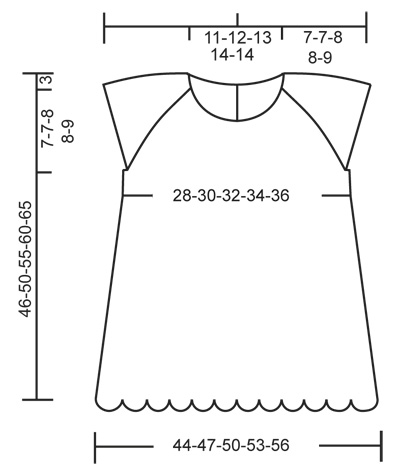
|
|
|
Have you made this or any other of our designs? Tag your pictures in social media with #dropsdesign so we can see them! Do you need help with this pattern?You'll find tutorial videos, a Comments/Questions area and more by visiting the pattern on garnstudio.com. © 1982-2024 DROPS Design A/S. We reserve all rights. This document, including all its sub-sections, has copyrights. Read more about what you can do with our patterns at the bottom of each pattern on our site. |
|







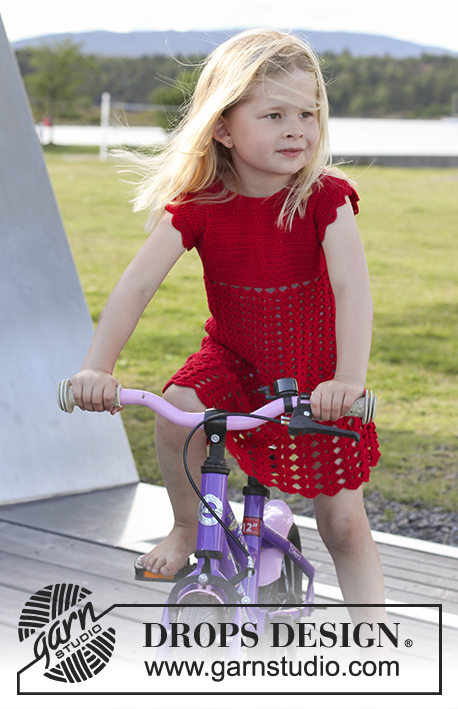




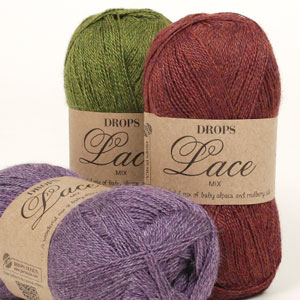




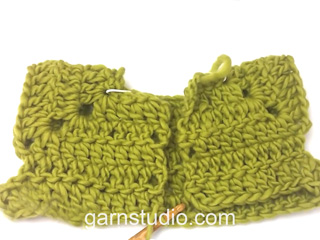
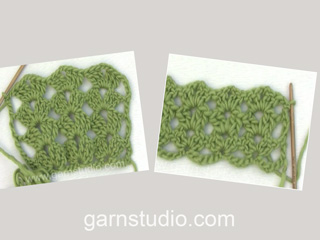



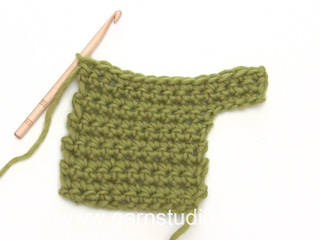
























Comments / Questions (39)
Forstår ikke hvordan 2st+2lm+2st (første økning) blir kun 12st økt? Blir det ikke 16? Får ingenting til å gå opp, hjelp! Haha :)
09.05.2019 - 22:52DROPS Design answered:
Hei Hanna. Du hekler i en fastmaske slik: 2 staver + 2 luftmasker + 2 staver. Du har nå 4 staver. Siden du hadde 1 fastmaske fra før (den du hekler i) har du altså økt med 3 masker - den masken du hadde fra før + 3 nye. Du gjør dette ved hvert merke og har 4 merker i arbeidet. Altså 3 masker økt , 4 ganger = 12 masker økt. God fornøyelse
13.05.2019 - 14:04Buongiorno, ho iniziato il modello per TG 2 anni ma non mi tornano i conti. Ad esempio il dietro sx si parte con 12 punti e prima di agganciare per le maniche se ne devono avere 28, ma non basta aumentare 6/7 volte...
27.04.2019 - 16:51DROPS Design answered:
Buongiorno Laura. Gli aumenti sono corretti. P.es sul dietro sinistro aumenta 2 m.a nel paragrafo che inizia con: LEGGERE LE INFORMAZIONI PER IL LAVORO ; poi deve aumentare 2 maglie alte per 7 volte. Quindi in tutto aumenta 16 maglie alte che aggiunte alle 12 iniziali, portano a 28 maglie alte. Buon lavoro!
28.04.2019 - 12:09Do you cut the yarn to work it on the rs? Or should they naturally fall on the rs?! X
14.10.2018 - 18:40DROPS Design answered:
Dear Nadine, the first row after the fundation chain is worked from WS (= the dc row where you will add markers). The row after = working with tr and inc in each st with a marker will be the first row from RS. Happy crocheting!
15.10.2018 - 10:38Buongiorno e grazie mille per la pronta risposta
31.08.2018 - 07:56Sto facendo quesro vestito in tg 5/6 anni. Alla fine dite che deve misurare 43 cm... questa misura va presa dal girocollo, dalla spalla o da dove dite che il lavoro deve iniziare ad essere misurato?
30.08.2018 - 23:00DROPS Design answered:
Buongiorno Silvia. I 43 cm vanno presi da dove dice: ora misurare il lavoro da qui. Nel grafico in fondo alle spiegazioni, trova le misure complete del vestito. Buon lavoro!
31.08.2018 - 06:58Buonasera sono alle prime armi con la realizzazione dei vestiti non ne ho mai fatto uno Sto provando a fare questo modello in taglia 5/6 anni...sono solo all'inizio sto facendo lo sprone e sono alla fine dell'ottavo giro di aumenti per il raglan mi trovo sul diritto del lavoro al termine del dell'ottavo raglan... lo schema e richiede di continuare a lavorare sul diritto del lavoro come devo fare?Devo tagliare il filo e ricominciare da capo e come faccio a riconoscere Quale' il dritto?
29.08.2018 - 18:59Grazie per il suggerimento ma continuo a non capire. Finisco l'ultimo ventaglio della riga. Come chiudo e comincio il giroi successivo?
20.07.2018 - 10:31DROPS Design answered:
Buongiorno Loredana. Dopo l'ultimo ventaglio nell'ultimo arco di catenelle del giro, lavora maglie bassissime fino al primo arco di catenelle e poi riprende con i ventagli. Buon lavoro!
20.07.2018 - 10:57Buongiorno, domanda da principiante: per chiudere il giro quando incomincio la lavorazione con il punto a ventaglio come faccio? io ci sto provando ma mi viene tutto storto. Dopo l'ultimo punto a ventaglio chiudo con una maglia bassissima alla base del primo punto a ventaglio, continuo con 1 p.to bassissimo per ogni catenella del primo ventaglio fino ad arrivare alla prima asola. Ma così facendo la "cucitura" è tutta obliqua. Grazie mille
20.07.2018 - 09:11DROPS Design answered:
Buongiorno Loredana. Provi a non lavorare la maglia bassissima alla base del primo punto a ventaglio. Buon lavoro!
20.07.2018 - 10:27The stitch counts are the same for size 5/6 and size 7/8. That doesn’t make any sense to me. Can you help clarify this?
13.03.2018 - 15:36DROPS Design answered:
Dear Sue, the number of sts to cast on ie to start with is the same in these both sizes but you will increase more times in the larger size so that the total number of sts at the end of yoke will be larger and yoke will be longer in size 7/8 than in size 5/6. Happy crocheting!
13.03.2018 - 15:56Lena Chan wrote:
Thank you so much for this lovely pattern! I made it for my Daughter as her Chinese New Year dress and even though I unknowingly ended up with 4 more stitches at the end of the yoke, the dress still turned out well 😆 I did however add another row to the yoke before the crochet in a round step in order to make the arm hole bigger as I thought it would be too tight. I also sewed a lining and sewed a row of lace at the bottom of the lining to make it similar to the photo.
08.03.2018 - 08:17